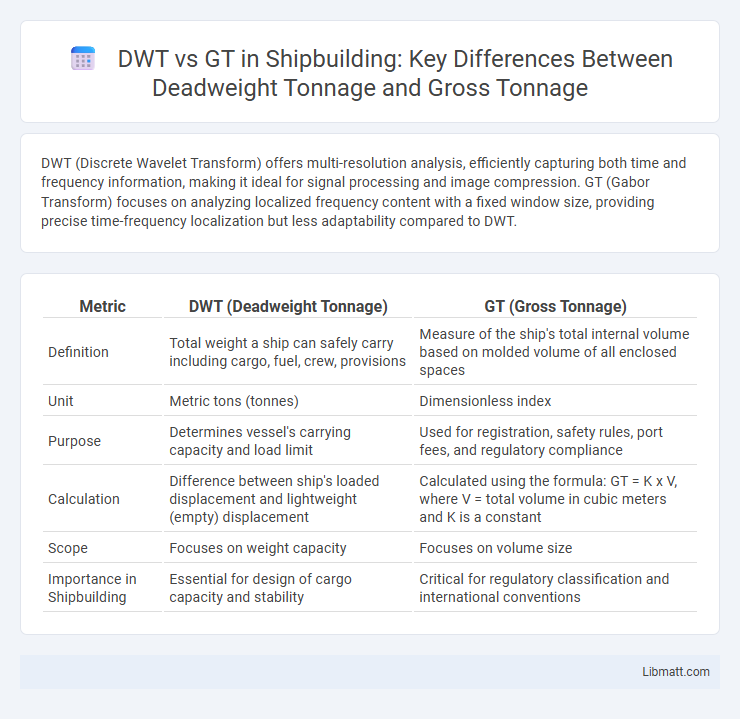DWT (Discrete Wavelet Transform) offers multi-resolution analysis, efficiently capturing both time and frequency information, making it ideal for signal processing and image compression. GT (Gabor Transform) focuses on analyzing localized frequency content with a fixed window size, providing precise time-frequency localization but less adaptability compared to DWT.
Table of Comparison
| Metric | DWT (Deadweight Tonnage) | GT (Gross Tonnage) |
|---|---|---|
| Definition | Total weight a ship can safely carry including cargo, fuel, crew, provisions | Measure of the ship's total internal volume based on molded volume of all enclosed spaces |
| Unit | Metric tons (tonnes) | Dimensionless index |
| Purpose | Determines vessel's carrying capacity and load limit | Used for registration, safety rules, port fees, and regulatory compliance |
| Calculation | Difference between ship's loaded displacement and lightweight (empty) displacement | Calculated using the formula: GT = K x V, where V = total volume in cubic meters and K is a constant |
| Scope | Focuses on weight capacity | Focuses on volume size |
| Importance in Shipbuilding | Essential for design of cargo capacity and stability | Critical for regulatory classification and international conventions |
Introduction: Understanding DWT and GT
Discrete Wavelet Transform (DWT) is a signal processing technique that analyzes data at multiple resolutions by decomposing signals into wavelet coefficients, enabling efficient feature extraction and noise reduction. Graph Transform (GT) operates by leveraging the structure of data represented as graphs, performing spectral analysis based on graph Laplacians to capture relationships among nodes for applications like image compression and network analysis. Both methods enhance data interpretation but differ in approach: DWT focuses on time-frequency localization while GT exploits graph topology for signal representation.
Defining Discrete Wavelet Transform (DWT)
Discrete Wavelet Transform (DWT) is a mathematical technique used to analyze signals by decomposing them into different frequency components while preserving time information. It applies a series of filters to break down data into approximation and detail coefficients, enabling multi-resolution analysis. DWT is widely utilized in image compression, denoising, and feature extraction due to its efficiency in representing both frequency and spatial information.
What is Graph Theory (GT)?
Graph Theory (GT) is a branch of mathematics that studies the properties and relationships of graphs, which consist of nodes (vertices) connected by edges. It provides powerful tools for analyzing complex networks such as social networks, communication systems, and biological pathways. Understanding GT can enhance your ability to model and solve problems involving interconnected data structures efficiently.
Key Features of DWT
Discrete Wavelet Transform (DWT) offers multi-resolution analysis essential for signal and image processing, enabling decomposition into frequency sub-bands with localized time and frequency information. Its ability to efficiently capture both transient and stationary features makes it highly suitable for applications in compression, denoising, and feature extraction. DWT's inherent sparsity and invertibility ensure minimal information loss while preserving critical signal characteristics compared to traditional Fourier-based methods like the Gabor Transform (GT).
Core Principles of GT
Grounded Theory (GT) is based on the systematic generation of theory through the collection and analysis of qualitative data, emphasizing continuous comparison and iterative coding processes. Core principles include theoretical sampling, constant comparative analysis, memo-writing, and the generation of categories that form an emergent theory grounded deeply in observed data. Unlike Discrete Wavelet Transform (DWT), which is a mathematical tool used for signal processing, GT focuses on qualitative data and theory development in social sciences.
DWT vs GT: Methodological Differences
Discrete Wavelet Transform (DWT) decomposes signals into different frequency components using scalable and translatable wavelets, enabling multi-resolution analysis ideal for non-stationary data. The Gabor Transform (GT) applies a Gaussian window to segment the signal in time and frequency domains simultaneously, offering localized time-frequency representation with fixed resolution. Unlike DWT's hierarchical approach with varying time-frequency resolution, GT provides uniform resolution determined by the window size, impacting its effectiveness in analyzing signals with different time-frequency characteristics.
Applications of DWT and GT
Discrete Wavelet Transform (DWT) is extensively used in image compression, signal denoising, and feature extraction for pattern recognition, leveraging its ability to analyze data at multiple resolution levels and capture both frequency and temporal information. Graph Transform (GT) excels in processing data defined on irregular structures, with applications in network analysis, sensor data processing, and brain signal interpretation, owing to its proficiency in handling complex graph topologies. Both DWT and GT contribute significantly to advanced data analysis by transforming signals into domains that reveal critical structural and frequency characteristics.
Advantages and Limitations of DWT
Discrete Wavelet Transform (DWT) excels in multi-resolution analysis, offering superior time-frequency localization compared to the Fourier Transform (GT), making it ideal for analyzing non-stationary signals. Its advantages include efficient data compression and denoising, reduced computational complexity, and the ability to capture both transient and long-term signal features. However, DWT can suffer from boundary artifacts and may require careful selection of wavelet types and decomposition levels to optimize performance for your specific application.
Strengths and Weaknesses of GT
Ground Truth (GT) data provides highly accurate and reliable reference points essential for validating and training algorithms, especially in image analysis and machine learning. However, obtaining GT data is often time-consuming, costly, and subject to human bias, which can limit its scalability and applicability across diverse datasets. Your ability to leverage GT effectively depends on balancing its precision with practical constraints in data annotation processes.
Choosing Between DWT and GT: Which Is Better?
Choosing between DWT (Discrete Wavelet Transform) and GT (Generalized Transform) depends on the specific application and data characteristics. DWT excels in signal processing tasks requiring multi-resolution analysis and efficient noise reduction, while GT offers flexibility in transforming data with customized basis functions for complex patterns. Evaluating factors such as computational complexity, data dimensionality, and preservation of signal features guides the optimal choice between DWT and GT methods.
DWT vs GT Infographic

 libmatt.com
libmatt.com